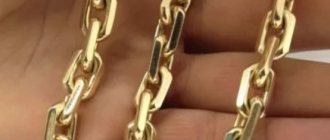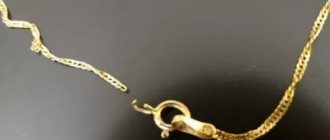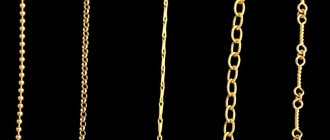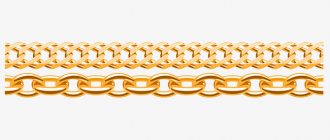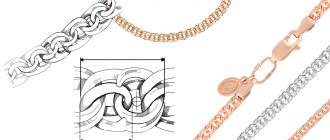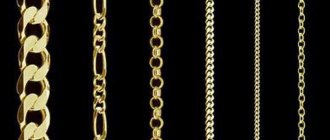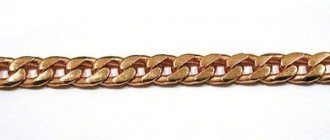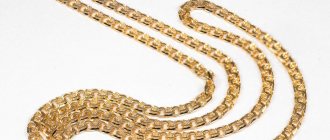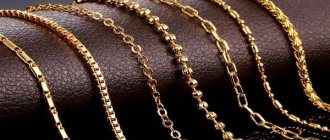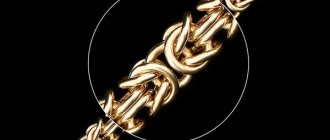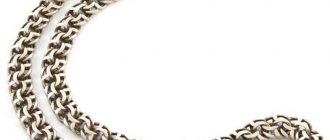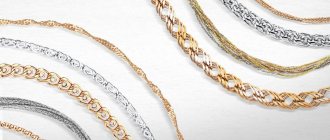Today, in any archaeological museum in the world you can see displays of objects from ancient times. Already at that period, people devoted a lot of time not only to basic household items, but also to jewelry; they were made from various metals and alloys, which did not always have the value of the material used, but contained artistic appeal and originality. All chains were made by hand and had very complex and unique weaving patterns.
Many modern jewelers who have the latest jewelry production equipment at hand cannot understand how most of the chain weaves were made. Today there is no exact answer to the question of how ancient people came to the mass production of jewelry. But we can definitely say that the current fashion of decorating your body with exquisite items made of metal and stones originates from antiquity.
Chain making methods
- Despite the fact that in our time many simplifying techniques and tools have been created for jewelers, coming up with something new is a difficult task. Any piece of jewelry is a manifestation of creativity and imagination, which are becoming increasingly difficult to extract from oneself. Typically, jewelers work in tandem with a jewelry designer.
- Chains are considered the most common and relevant jewelry among women and men today. They can easily be worn as an independent accessory, or strung together with a medallion, pendant, or cross.
- Considering the great demand for this type of jewelry, a large number of chain weaving techniques have been invented and created over many centuries.
Today, the most common are three methods of making chains:
- machine;
- using stamping;
- manual;
Machine
- The machine method consists of special machines .
- The metal from which the links are made is poured into them.
- Later, chains of various lengths will be formed from these parts and a lock will be inserted using other equipment.
Punching method
- Stamping is a method of making chains that requires the hands of a professional jeweler. In this case, the master works with ready-made cast links. Its task is to correctly fix the individual elements, according to the preliminary sketch.
- This option is more expensive than the previous one. Its main disadvantage is poor strength. Over time, the links can twist and break at the joints.
Manual
- The third, manual method of making chains is the most expensive and highly artistic. Only people with a good income can afford such products.
- The main reason for this price is the very complex technology for creating each element.
- First, the master winds a wire made of precious metal onto a base to form a spiral .
- After this, the jeweler uses a special tool to cut it into small links.
- When all the parts are made, he begins to shape the product itself using pliers.
- Then, for strength at the joints, the links are soldered by hand.
- After this, the product is placed under a special press to give it an ideal shape.
- Only after going through all these stages can a lock be inserted into the chain, after which it is sent to the jewelry store window.
Flaws
The main problem with tourniquets is that they easily form creases. It is better not to bend such a chain, and you absolutely cannot sleep in it! You need to be very careful with the snake. Before purchasing, be sure to carefully inspect the product to make sure there are no creases. Be carefull!
Creases form easily, and this is the weak point of such a beautiful and versatile chain. Moreover, the thinner the chain, the more susceptible it is to this “disease”. Moreover, on chains with a small weight, it is unlikely that they will undertake to fix the creases even in workshops. In addition, many girls note that hair gets tightly wrapped around the chain-braids, so much so that it is impossible to untangle them.
These are, perhaps, all the shortcomings that are more than compensated by the beauty, advantages and careful handling of the jewelry.
Additional types of chain weaving
These types of chain weaving have their own joining techniques, which do not belong to either the anchor or armor type of weaving:
- “Spike” - this technique is a smooth, dense cord reminiscent of ears of wheat. A chain woven in this way is very strong.
Tight weave
- “Perlina” - in this technique the main elements are metal beads. The basis of this method is the stringing effect.
Perlina
- "Bismarck" is a very tight connection of large links. This chain looks very massive. Most often, this type of weaving is preferred by men.
Durable chain
- “Round Bismarck” - consists of rounded parts intertwined with each other. The result is a voluminous product, which is also mainly chosen by men.
Round subspecies
- “ Arab Bismarck” - two rows of rings are connected to each other with additional rods and soldered.
Arabian view
- “Stream” - semi-oval links are connected in such a way that they resemble a stream. The main advantage of these chains is their light weight with an impressive volume.
Brook
- “Royal weaving” - this type of weaving has the second name “Fox tail”. It is characterized by small round links that, when connected, form a braided pattern.
Fox's tail
- "Python" is a sequential connection of identical particles. As a rule, it has a large width. This technique was originally created for men, but many women also like it.
For both women and men
- “Saturn” is a type of stringing in which some links are placed on top of others.
Stringing
- “Chamomile” is an overlay of many links among themselves, creating a multi-layered structure. When making this technique, you cannot do without a jeweler. The final version looks very openwork and voluminous.
Multi-layer weaving
- “Rope” - made by twisting iron threads. Outwardly, they are very similar to an ordinary braided rope or tourniquet.
Rope
- “Turtle” - this chain is folded using flat and round links, reminiscent of chain mail or shell. She is equally in demand among both men and women.
Turtle
- “Fantasy” - this technique has many different types of execution, which modern jewelers are constantly improving, inventing new ones. As a rule, this is a combination of new and old techniques into one at an experimental level.
One of the types
Anchor weaving
“Rollo” is a chain of simple anchor weave with faceted round or elongated links, similar to hexagons, which gives the decoration a brutal look. "Rollo" has a variation - "Rollo Trampoline"; the links of such a chain seem to be flattened from the blow (in fact, the name comes from the Italian battuta - “blow”).
“Cobra” weaving is similar to “rollo” in everything, but differs from the latter in the diameter of the chain: “cobra” cannot be thicker than 0.5 cm, and, as a rule, its diameter is even smaller. Due to the weightlessness of the weave, jewelers also call it “sand”. And of course, the suspension for the Cobra should not be heavy and large.
“Garibaldi” is a voluminous anchor weave with paired round links. It is believed that he was named after the Garibaldi couple, heroes of the Italian liberation movement, who were always together and shared each other's views. “Garibaldi” gives the impression of a very durable and solid weave, so it is suitable for wearing a cross or a talisman pendant.
“Tonda” is a basic type of anchor weaving, the links of which are never processed with diamond cutting. The main feature of the “Tonda” is its smoothness and elegance: the links of the “Tonda” weaving chain are similar to paintings by Renaissance artists. Paintings and bas-reliefs called tondo (short for the Italian rotondo - “round”), as a rule, depicted angels or the Madonna and Child. We recommend the Tonda weaving chain for children: it does not twist, does not cling to clothes or hair, and is ideal for a cross or icon. A variety of “tonda” - “Tonda oval” - as the name suggests, consists of elongated oval links, however, as smooth and graceful as those of the basic weave.
“Cord” is an anchor weave that creates the effect of a twisted chain. In a “cord” several links emerge from one link at once; the first connects to the neighboring one, and the others jump over one, two or three links, forming “steps”.
Similar to “cord” both in appearance and in name, “triple cordino” weaving. But, unlike the “cord”, the links in it are not so tightly spaced, so the “triple cordino” chain looks a little looser.
“Forzatina” is an anchor weave, the links of which look as if the chain has been forcefully stretched along its length. Its variety “forzatina rada” (Italian for “rare”) is a simple connection of elongated links, free weaving, equally suitable for both men and women. “Forzatina rada pernod” has a transverse bridge inside the link, which further shifts the character of the decoration towards the brutal.
A separate type of weaving - “forzatina dopia” - resembles both “cord” and simple double anchor weaving, but the “twisted” nature makes such jewelry more suitable for women.
What type of chain weaving should I choose?
- When choosing the type of chain weaving, you need to start from several key points. One of them is visual appeal. Of course, in order to wear a product with pleasure, its owner must like it, first of all, in appearance. The feeling of wearing something attractive and beautiful can lift your spirits even in the most unpleasant situations.
- The second aspect that is worth paying attention to is the repairability of the product . Of course, in our world there are practically no products left that cannot be corrected. However, it is best to choose options for weaving jewelry in which it is easy to replace the desired part. Then any jeweler will be able to cope with this task.
- Another important factor is the price of the product. If you don’t have enough money to buy the chain you like, don’t rush to make another choice. Wait until you can afford to buy a chain with the weave you like or ask for a discount. In this case, the purchase will bring you the greatest pleasure.
When choosing chains, you must first rely on your taste. However, there are options, some of which will look best on women, others on men.
- Women should take a closer look at chains made using the Lavs, Python, Nonna and Venetian weaving techniques.
- Bismarck , will look good on men
As for the length of the product, chains up to 50 cm will look like a winning option for women, and up to 60 cm for men.
- When buying a chain for a child of any gender, it is better to give preference to options made of silver. Firstly, when buying a silver product, you should not worry that it may break, since it is a strong metal. Children are usually very mobile and can accidentally break the chain.
- Secondly, as statistics show, children always prefer silver over gold. It is also better to choose chains that are more openwork and not heavy, so that they are comfortable to wear. Tondo weaving is popular for children
pros
Snake has a lot of advantages. You need to choose a chain based on several characteristics.
Firstly, age. A snake chain is suitable for a person of any age: small children usually do not buy gold and silver chains, but teenagers and young people are happy to choose snakes for themselves.
You can choose round or flat, depending on your taste. Older people can also easily choose a snake chain for themselves, but only the classic model. Those. The advantage of Snake is that such a chain is suitable for every age.
Secondly, the snake chain is universal, suitable for different outfits and clothing styles. It all depends on the situation. For example, if you decide to shine at a concert in a chic floor-length dress, then feel free to complement the look with a snake with an elegant pendant.
There is also an unspoken rule: the larger a person wears a chain, the more noticeable the chain should be in order to look harmonious.
But such an effective and versatile chain also has disadvantages; you need to know about them before purchasing in order to weigh the pros and cons in advance.
How to choose the right lock for a chain?
- When you have already decided on the type of weaving with which the chain should be made, you should pay attention to the choice of lock. This is the element that should harmoniously complement the main part of the product.
- When choosing a lock, you need to consider how you will put the product on. It’s good if there are always people next to you who can easily help you put on jewelry. However, it is better to give preference to a lock that you can easily open and close yourself.
The most popular today are two types of chain locks:
- Carabiner - made in the form of a small loop on a spring, which works by snapping.
- Spring lock - is a small structure with a spring mechanism.
For delicate chains
Both types of locks are very simple and easy to use. Most often, the first option is used in massive jewelry, using the Bismarck type of weaving. And the second one is well suited for openwork and small chains - “Ochio di Pernice”, “Tsar”, “Lavs” .
Armor weaving: cords
Among the chains of armored weaving there is a group of “cords” - smooth chains with a round or square cross-section. In addition, “cords” are divided into soft and hard. As a rule, single cords are a safe bet for almost any pendant.
“Snake” is a round chain that looks like snake skin. The tightly knit links in this weaving are connected at an angle: thanks to this, the chain in motion really looks like it’s alive. There is also a “square” “snake”, which looks more avant-garde.
“Snake” is another type of weaving, similar to a snake, but unlike “snake”, the links here are not located diagonally, but horizontally along the axis of the chain.
“Amygdala” is a smooth chain-cord with zigzag links. The density and flexibility of the “almond” allows you to weave braids from three, four or five such chains, which are worn as an independent decoration without a pendant.
“Voa oval” (or “double gurmet”) is a weave that resembles a tightly compressed spring. Transverse diagonal lines add dynamics and help create the image of an active modern woman.
The “gourmet oval” weave is very similar to the “snake”, but the cross-section of such a chain is not round, but oval.
“Triple trampoline” is another weave similar to “snake”, but with longer links. This weaving is the basis of the “triple cordino” chain, as if stretched to a twisted chain of links connected like an anchor.
By the way, the “Chinese cord” weave is also similar to the “triple cordino”, but the links in it are located very tightly, justifying the name of this type.
“Montreal”, in turn, has a noticeable resemblance to the “triple trampoline”, but it is rather a flat cord with the appropriate cross-section. Three or four Montreal chains are often woven into braids: due to their texture and thickness, such jewelry is worn without a pendant.
“Parigina”, unlike “Montreal”, which is based on “double gourmet”, is made from ordinary single weave, so its pattern is simpler. Chain braids are also woven from “Parigina” (they come out more airy), sometimes combining it with “Montreal”.
Proper care of any chain weave
- No matter how carefully the owner of the chain wears it, sooner or later it may darken, and dirt will appear between the links. This is especially true for chains with voluminous and openwork weaving - “Korda”, “Triple Cordino”, “Singapore”, “Bismarck”, “Romashka”.
To solve this problem, you can purchase a special jewelry cleaning product at a jewelry store, or make it yourself.
To make a solution to remove dirt from a chain you will need:
- 1 tsp ammonia;
- soap remnants or soap shavings (can be replaced with washing powder);
- 1 tsp hydrogen peroxide;
- 100 ml warm water.
It is necessary to mix all the ingredients and place the product in a container with the solution for several hours. After this, the chain must be rinsed under running water and dried.
Useful articles on the site, we recommend reading:
- How to choose a kitchen knife
- Pulse oximeter: how to choose for home
- How to choose a wedding date
- How to choose the right Cahors
- How to choose between two guys
Snake silver chain
A cheaper metal compared to gold is silver. Therefore, if you love and wear silver, or if it is not possible to buy a gold chain, but you want to become the owner of jewelry, feel free to buy silver. There are more and more snake chains in this metal on the market.
If you buy a snake chain made of silver, it is advisable to have it rhodium-plated, so it will last much longer.
What you need to know when choosing a chain
Chains can rightfully be considered the most versatile and functional piece of jewelry.
The history of this accessory goes deep into antiquity. Chains were worn not only on the neck, but also on the arms and legs. Since ancient times, gold chains have been a symbol of power and prosperity, but today everyone can afford such a product. A wide range of materials and types of weaving makes it possible to choose an accessory that suits any outfit and occasion. The chain can be worn as an independent accessory or complemented with various pendants, pendants, crosses or amulet. Chains and bracelets are the type of jewelry that looks equally beautiful and harmonious on both sophisticated women and strong men, regardless of their age and status; such accessories are also often given to children and teenagers.
Chain weaving methods
Today, chains are created in three ways - machine knitting, handmade and stamping.
Weaving using the machine knitting is carried out using special machines. Such equipment makes it possible to produce incredibly thin links with a thickness of 0.15 mm. Everything happens automatically and, for example, when making an anchor weaving chain, the machine can connect up to 600 elements per minute. To seal the edges of the links, the finished chain is placed in a special oven.
But, despite modern technologies, some types of weaving are still done only by hand . For this purpose, special chain ties are used. The quality of such chains will directly depend on the level of skill of the jeweler, and the weight of such jewelry is usually about 6 grams. This process is very labor-intensive and painstaking. To begin with, the wire, silver or gold, is wound in a spiral on a pre-prepared base, then cut into links, which should be the same size, and then a certain pattern is created manually, using only pliers. To ensure that the links are well fastened and do not loosen, they are soldered, after which the finished chain is clamped between two special shafts, which makes it flat.
Stamped chains are woven from pre-made links, which are called “stamps”. Such products are considered the most short-lived, since in them the rings are simply threaded into one another and clamped, but the ends are not soldered, so the chain can easily twist when worn and become deformed.
Whole and hollow chains
Each chain, regardless of the type of weaving, can be either hollow or solid.
Hollow chains are light and voluminous. They are made from wire that is hollow inside, so even if outwardly the links look heavy and thick, in fact, the weight of such a chain will be small. The clear advantage of such products is their price category, which is determined by the weight of the decoration, as well as complex weaving and a massive, solid appearance.
Solid chains differ from hollow ones in greater weight and, accordingly, higher cost. But their advantage is that they are more comfortable to wear and less susceptible to deformation, which makes such an accessory durable. Even if suddenly several links are damaged, the jewelry maker can easily restore them to their original appearance.
Types of locks
When choosing a chain or bracelet, you need to look very carefully at the lock. This small element is very important, since it is primarily responsible for the safety of your accessory. The lock must be of high quality and also comfortable, so that a person can easily fasten and unfasten it independently.
The jewelry maker decides which lock to install based on the weight of the jewelry, as well as the type and volume of weaving. It is better to fasten massive and voluminous chains with the help of reliable, but quite large, carabiners, but a spring lock will look more harmonious with elegant and thin ones. There are also twist locks. Each of the fasteners allows you to easily complement the chain with an original pendant or cross, so their reliability and ease of wearing are considered equal.
Carabiner Spring lock Twist locks
Types of chain weaving
The type of chain weave is the way in which the links are connected to each other. The simpler it is, the easier it is to care for the jewelry, but at the same time, the more intricate and complex it is, the more reliable and durable the jewelry will be.
Jewelry craftsmen distinguish three basic types of chain weaving - Anchor, Armor and Bismarck. Chains were woven in this way many centuries ago. Time passed, fashion changed, and each master in his era tried to complement and make each weave more original, which is why today there are more than 50 options. Each of them has its own name and can be made of any precious metal.
Now let's look at the most popular types of weaving, which can be seen in every jewelry store.
Abinatha . One of the varieties of Bismarck weaving.
Aurora . This type belongs to the fantasy type of anchor weaving.
Bismarck or Kaiser . The only type of weaving that is considered exclusively masculine. Its execution is quite complex, especially some of its subtypes, because such chains are woven mainly by hand. Bismarck is a link consisting of several connected elements. This type of weaving can be either single, double, triple or even quadruple, therefore it has a significant volume and thickness. Breeze .
A subspecies of Venetian weaving, it consists of many round links interconnected. Venetian weaving. Mainly used to create bracelets. The links in this type are wider and thinner than in a standard anchor. They are generally made in square or rectangular shapes. There are double or triple Venetian weaving , it all depends on the number of elements connected into one block.
Rope or twisted weaving. Named because of its resemblance to ordinary rope.
Eight . One of the types of armor weaving. So named because the links are shaped like a figure eight. Elements can be connected both vertically and horizontally.
Hawaiian . Also a type of fancy anchor weaving.
Garibaldi . The technique of this method of knitting chains is very similar to rollo weaving, but here the links have a forked shape.
Panther's eye or peacock's eye . An original and reliable weave in which the links, when connected, create the shape of an eye.
Double anchor . A method in which elements with two rings are alternately connected.
Celtic knot . Quite voluminous weaving, refers to men's.
Celtic pattern . Massive weaving with many different details.
Cleopatra . The weave is similar to jewelry cord, but here the links are flat.
Cobra . A subtype of jewelry cord with an oval or square hollow section.
Kolos . This technology is vaguely reminiscent of the two previous types of weaving presented, but differs in that here all the links are directed in one direction.
Chainmail weaving.
It differs from the others in the large number of elements used. Cord weaving.
This type differs from those already listed in that in it the links are fastened to each other not one by one, but several pieces in one ring, while making a jump of 2-3 links, which is why the chain twists. Royal Bismarck or Byzantine weave . The links are loosely connected to each other and directed in different directions.
Crocea . One of the types of Venetian weaving, consists of rounded links.
Round bismarck .
Consists of many links connected to each other. Love .
This type of chain knitting received such a romantic name because the links are shaped like hearts. Products made in this way are very feminine and delicate. Fox tail or herringbone . The direction of the links is similar to Byzantine weaving, but in this version they are already tightly compressed and in cross-section such a chain has the shape of a circle.
Mantle . The weaving is quite complex, since rings and springs are used here.
Montreal . Using this method, thin flat strands are made, which are then woven into braids.
Sea anchor . The same anchor weaving, only inside the usual oval links there is an additional partition in the middle.
Moscow Bismarck or Cardinal .
There are two types, with four link rations and with six. It is assembled using the same method as the classic Bismarck, differing only in the soldering of the links. Nonna .
The full name in Italian is “maglia della nonna”, which translates as “grandmother’s weaving”. This species is also called the combined shell. It consists of links of two sizes, the smaller one fits into the larger one. Outwardly, such chains look gentle and elegant, but in fact they are very durable. Armor weaving. It was this technology that was taken as the basis for the creation of many types of decorative weaving. Such chains consist of flat links, ground on both sides, fastened to each other perpendicularly so that they are in the same plane.
Armor knocked together or serpentine . Consists of curved links tightly pressed to each other.
Perlina . Unlike other types of weaving, this one uses balls connected by thread as links. Such balls may not necessarily be round; they are often made oval or cylindrical. Also, such chains are made both using elements of the same shape and alternating them with each other.
Persian night . The rings in this type of chain weaving are located both horizontally - base, and vertically.
Python . This type of Bismarck is also suitable for women, since this weaving is very light, openwork, although voluminous. This type of chain knitting is also often called caprice, American, Italian, Pharaoh and Persian.
Semi-volumetric or springel bismarck . In cross-section, such a product looks like an irregular oval, and the thickness of the chain is slightly greater than or equal to the width of the link.
Popcorn. A very original round hollow weave that looks like popcorn, which is why it got its name.
Rose or courage . Weaving such a chain is carried out only by hand. Here they use not just links, but twisted spirals, which, when connected, create a three-dimensional flower.
Rollo or belzer . This type simply uses round links. One of the famous fashion houses, namely Chopard, often included chains of this type in their collections, which is why it has another name - Chopard.
Rhombus or rhombo . This is one of the types of armor weaving in which diamond-shaped links are connected. This knitting can be single, double or triple.
Brook .
This is a variation of the Bismarck with flat, hammered links. Singapore .
It also belongs to a variety of armor weaving and, thanks to the slightly curved links, the chain twists. Snowball . Consists of volumetric, openwork elements.
Snake , jewelry cord or tondo .
The presented type of weaving is very dense, hollow and has a round cross-section. Due to the slight zigzag effect, such a chain resembles a snake, which is why the weaving is called “snake”, which translates as snake. Superdisc . Type of weaving Singapore. Characterized by tight compression of elements.
Knocked into a circle . The tightly compressed elements create a round jewelry cord.
Snail or paper clip . Consists of links that are twisted in a spiral inward. This species is also called lumakina, which is translated from Italian as snail.
Figaro or Cartier . This is another subspecies of armor weaving. It consists of links of different sizes and shapes, which alternate sequentially, for example, three small ones, then one large one and again three small ones.
Florence . The weave is very similar to chain mail, but more airy and with fewer elements.
Turtle .
In this type, the links have an original lamellar structure, which resembles a tortoise shell. Anchor weaving . The very name of this type of chain knitting suggests that it was given because of its complete external resemblance to a real anchor chain. The classic version consists of oval-shaped links.
The list of types of weaving presented to your attention is far from complete, since there are many more types of fancy chains.
They combine various precious metals, decorative links and multi-layering. Each of the weaves is equally suitable for any precious metal. There are no separate types suitable, for example, only for gold.
Which weave should you choose?
First of all, you should start from your own likes and preferences. But, when choosing, it is still worth considering that some types of chains may be exclusively for women, and some only for men. For example, Bismarck weaving is distinguished by its massiveness and volume, therefore it will look more advantageous and respectable on the stronger half, but the graceful Nonna, Singapore, rose or lava weaving are purely feminine decorations. But the anchor, and all the weavings coming from it, are equally harmoniously suitable for everyone, regardless of gender or age.
Selecting the correct chain length
The length of the chain is an equally important criterion when choosing jewelry. Basically, the size range starts with chains 35 - 40 cm long. Women are recommended to choose jewelry up to 50 cm long, and for men, on the contrary, from 50 cm. If it is not possible to try on a chain before purchasing, the following images will help you find your bearings. When choosing the length, you should also take into account the build of the person who will wear this jewelry.
